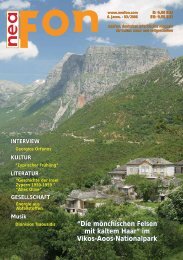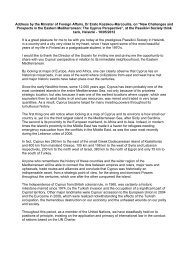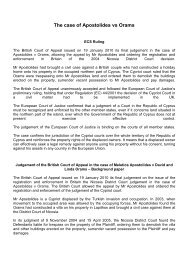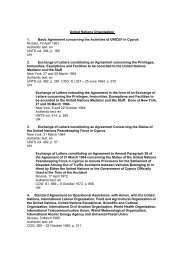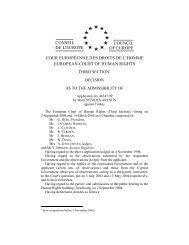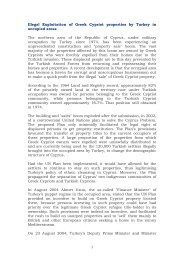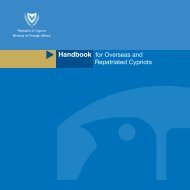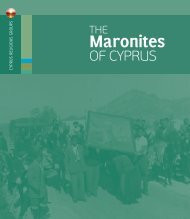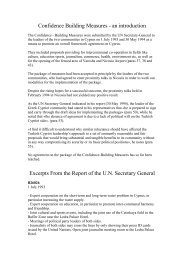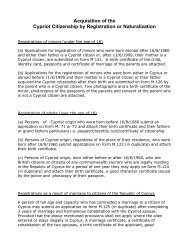LATINS ENG 2012:Layout 1 - Ministry of Foreign Affairs
LATINS ENG 2012:Layout 1 - Ministry of Foreign Affairs
LATINS ENG 2012:Layout 1 - Ministry of Foreign Affairs
You also want an ePaper? Increase the reach of your titles
YUMPU automatically turns print PDFs into web optimized ePapers that Google loves.
ContentsForeword 5A Message from the Representative <strong>of</strong>the Latin Religious Group 7A Brief History 8Frankish and Venetian Era 8Ottoman Era 9British Era 11Independence Era 15Demographic Pr<strong>of</strong>ile 16Important Personalities 17The Latin Church <strong>of</strong> Cyprus 19Churches and Chapels 20Educational Institutions 22Community Organisations and Activities 24Monuments 25The Heritage <strong>of</strong> the Frankishand the Venetian Era 26Cemeteries 29Chronology 30References 31
ForewordUnder the Constitution <strong>of</strong> the Republic <strong>of</strong> Cyprus, the Armenians, the Latins and the Maronites <strong>of</strong> Cyprus arerecognized as “religious groups”. In a 1960 referendum, the three religious groups were asked to choose tobelong to either the Greek Cypriot or the Turkish Cypriot community. They opted to belong to the Greek Cypriotcommunity. The members <strong>of</strong> all three groups, therefore, enjoy the same privileges, rights and benefits as themembers <strong>of</strong> the Greek Cypriot community, including voting rights, eligibility for public <strong>of</strong>fice and election to <strong>of</strong>ficialgovernment and state positions at all levels. Moreover, the Armenian, Latin and Maronite religious groups, whichvote in the Parliamentary Εlections as part <strong>of</strong> the Greek Cypriot community, elect also one Representative eachfrom their ranks to the Cyprus House <strong>of</strong> Representatives. These non-voting Representatives attend meetings butdo not participate in the House deliberations. Nevertheless, they are consulted on legislative issues <strong>of</strong> particularinterest to their respective group.The series <strong>of</strong> publications “Cyprus Religious Groups” is intended as a basic overview, an introductory pr<strong>of</strong>ile, onthe Armenians, the Latins and the Maronites <strong>of</strong> Cyprus. These short publications are by no means exhaustive onthe subject and do not deal with differences <strong>of</strong> opinion and interpretation that may exist among scholars andother experts on issues related to the three groups.This publication series, initiated by the Press and Information Office, has been undertaken with the closecooperation <strong>of</strong> the Representatives <strong>of</strong> the three religious groups in the House <strong>of</strong> Representatives, and theirsignificant contribution is deeply appreciated. They kindly undertook the preparation <strong>of</strong> the text and alsoprovided the photographic material. They, therefore, deserve the credit and are also responsible for thecontent. The Press and Information Office undertook the overall coordination and production <strong>of</strong> the publicationsincluding editing, designing and printing.It is our hope that this series will stimulate more public and scholarly interest about the Armenian, the Latinand the Maronite religious groups <strong>of</strong> Cyprus.DirectorPress and Information Office5
THE <strong>LATINS</strong> OF CYPRUSA Message by the Representative <strong>of</strong> the Latin Religious Groupin the House <strong>of</strong> Representatives, Mr Benito MantovaniDear reader,On behalf <strong>of</strong> the Latins <strong>of</strong> Cyprus, I wish to express my sincere thanks to the Press andInformation Office for its initiative to issue this publication pertaining to the Latinreligious group.The presence <strong>of</strong> Latins (Roman Catholics <strong>of</strong> European or Levantine descent) in the area<strong>of</strong> Cyprus dates back to 1126, before the glorious periods <strong>of</strong> the Frankish andthe Venetian Era. However, today’s Latin community essentially comprises <strong>of</strong> thedescendants <strong>of</strong> Roman Catholics who settled on the island during the Ottoman and theBritish Era. Since 1960, the Latin community is constitutionally recognised as a religious group and has an electedRepresentative in the House <strong>of</strong> Representatives. The Latin religious group is fully integrated into the Cypriotsociety and the common link amongst their members is their Roman Catholic creed.I welcome this initiative <strong>of</strong> the Press and Information Office, which allows the reader to be informed about theexistence <strong>of</strong> the Latin religious group in Cyprus, its historical course and its contribution to the Cypriot society.7
THE <strong>LATINS</strong> OF CYPRUS● An old view <strong>of</strong> the Bellapais Abbey, which has been ruined since the 1974invasion <strong>of</strong> Cyprus by Turkey.●The last Queen <strong>of</strong> Cyprus, Caterina Cornaro,who reigned between 1474 and 1489.During the Frankish and the Venetian Era, thousands <strong>of</strong> Roman Catholics lived in Cyprus, representing 15-20%<strong>of</strong> the total population, but exercising a strong influence, as they were the ruling class <strong>of</strong> nobles andaristocrats. The secular Latin population came from Aragon, Catalonia, Florence, Venice, Genoa, Marseilles,Naples, Pisa, Provence, Syro-Palestine and Tuscany. There were also a few affluent Armenian Catholics fromthe Kingdom <strong>of</strong> Cilicia. After the Fall <strong>of</strong> Acre in 1291, Cyprus became the easternmost bulwark <strong>of</strong> Christianity,the most important commercial centre in the Levant and probably the richest kingdom <strong>of</strong> all Europe.Ottoman Era: Following the conquest <strong>of</strong> Cyprus by the Ottomans, around 1570-1571, thousands <strong>of</strong> Latinnobles and clerics were slaughtered or exiled. Others migrated to Rhodes, Malta, Lebanon and elsewhere,while several Latin churches were turned into mosques. At the same time, the Latin Church was essentiallydissolved while the new rulers restored the Greek Orthodox Church as the only representative ChristianChurch on the island. The few Latins who survived the massacres and chose to remain in Cyprus were giventwo options: either to become Greek Orthodox or to embrace Islam. However, being devout Catholics, many<strong>of</strong> them chose a third path: they became Linobambaki Crypto-Christians), hiding their worship and holdingonto the hope that the Ottomans would leave Cyprus. Legends also speak <strong>of</strong> Lusignans and Venetians whowent into hiding on the Troodos and Pentadaktylos mountains and the Carpass peninsula, some <strong>of</strong> whomreturned to Catholicism during the British Era.9
THE <strong>LATINS</strong> OF CYPRUS●Old post-card showing Saint Sophia’s cathedral in Nicosia, which was turned into the Selimiye mosque by the Ottomans.Although most Latins perished, the Franciscans didmanage to return and establish in 1596 the Holy CrossMonastery in Nicosia and the Monastery <strong>of</strong> Our Lady<strong>of</strong> Graces in Larnaka; these establishments were alsoused for the accommodation <strong>of</strong> European merchants,seafarers and travellers. At the same time, a smallLatin community timidly began to form in the early17th century, mainly in Larnaka, initially by Venetians,as the Most Serene Republic <strong>of</strong> Venice had enteredinto a peace agreement with the Ottomans in 1573.Contributing to the increase <strong>of</strong> Larnaka’s secular Latinpopulation was the presence <strong>of</strong> the consulates, which<strong>of</strong>fered protection and employment opportunities tovarious Europeans.Later on, during the 17th century, the Latin communitywas slightly strengthened by Capuchin monks,Armenian Catholics and Greek Catholics (Uniates). In1646 the Franciscan brothers established the TerraSanta School next to the Holy Cross Monastery, theoldest school still operating in Cyprus, at whichthousands <strong>of</strong> students from all the communities <strong>of</strong>the island were educated, as were non-Cypriots whowere sent there as boarders <strong>of</strong> the school. From the18th century and, mainly, the 19th century onwards,the island’s Latin population increased with thearrival <strong>of</strong> European bankers, diplomats, doctors,landowners and merchants, who mainly resided inLarnaka’s Frankish quarter. The newly-arrived camefrom France, Italy, Spain, Austria, Malta and Dalmatia,while some <strong>of</strong> them were Levantines.In 1844, sisters <strong>of</strong> the newly-formed Order <strong>of</strong> SaintJoseph <strong>of</strong> the Apparition settled in Larnaka, wherethey founded a nunnery, housing the first hospitaland pharmacy <strong>of</strong> the island. They also founded SaintJoseph’s School, the island’s first school for girlswhich, in the 145 years it operated, accommodatedand provided an excellent education to thousands <strong>of</strong>schoolgirls from all the communities <strong>of</strong> the island,10
THE <strong>LATINS</strong> OF CYPRUS● The Holy Cross church in Nicosia in the 1950s.● Mediaeval map <strong>of</strong> Nicosia (1573).●Saint Joseph’s Nunnery in Larnaka (mid-19th century).while serving also as an important factor in thespread <strong>of</strong> francophony in Cyprus. With the numericalincrease <strong>of</strong> Limassol’s Latin population and in thespirit <strong>of</strong> fundamental reforms in the Ottoman Empire,known as the Tanzimat reforms, a Franciscan conventwas established in 1850. Furthermore, in 1872 theerection <strong>of</strong> Saint Catherine’s church began. Based onvarious estimates, the Latin community <strong>of</strong> Cyprusnumbered around 400-600 persons in the mid-19thcentury, the majority <strong>of</strong> whom resided in Larnaka,with smaller numbers in Nicosia and Limassol.British Era: With the arrival <strong>of</strong> the British on theisland in July 1878, religious tolerance and a milderadministration also came about, which particularlystrengthened the already prosperous but small Latincommunity <strong>of</strong> the island. Participating in the firstLegislative Council (1879-1882) was the landowner11
THE <strong>LATINS</strong> OF CYPRUS● The Béraud family gathered on its mansion’s veranda in Larnaka (1890).Riccardo Mattei, together with a Greek Orthodox andtwo Muslims. During the first decades <strong>of</strong> the BritishEra, the Latin community <strong>of</strong> Cyprus grew in numberwith the addition <strong>of</strong> Roman Catholics from Malta,Spain and Britain, a few Armenian- Catholic refugeesfrom Cilicia, as well as some Maronites, who becameintegrated in the Latin community as they movedfrom their villages to the towns.●King James II deLusignan (1463-1473).Visible to the rightbelow is the Lusignandynasty crest.●Old photograph <strong>of</strong> the chapel <strong>of</strong> Saint Joseph’s Nunnery in Larnaka.12
THE <strong>LATINS</strong> OF CYPRUS●The impressive Famagusta Gate(1878).●The Holy Cross church in Nicosiain the early 20th century.During the British Era (1878-1960), many Latins servedas civil servants, entrepreneurs, bankers, doctors,merchants among other pr<strong>of</strong>essions. At the sametime, Saint Joseph’s School was established in Nicosia(1884), as well as the Terra Santa Schools in Limassol(1923), Famagusta (1952) and Kormakitis (1936), whichgreatly contributed to education on the island. Alsoestablished was the “Concordia” club (1903-1954) inNicosia, which had a significant impact on the capital’ssocial life. Over the years, Latin-Cypriots graduallybecame integrated into the wider Cypriot society,mainly through their education and work.13
THE <strong>LATINS</strong> OF CYPRUS●Commemorative photograph<strong>of</strong> Saint Joseph’s school inNicosia (early British Era).●View <strong>of</strong> Saint Joseph’s Nunnery in Larnaka.14
THE <strong>LATINS</strong> OF CYPRUS●Saint Anthony’s chapel at theLapierre manor in Kontea (1962).●View <strong>of</strong> Saint Catherine'schurch in Limassol.Independence Era: The 1960 Independence brought a new era for the Latins <strong>of</strong> Cyprus, who were recognisedas a religious group and were now represented in Parliament by an elected Representative. During the 1963-1964intercommunal troubles, the Latin-Cypriot community was not particularly affected. However, the second phase<strong>of</strong> the brutal 1974 military invasion by Turkey had an adverse impact on the Latin-Cypriot community as well: about30 families from Nicosia, Famagusta, Kyrenia and Xeros became refugees; the renowned Bellapais Abbey, the TerraSanta Schools and Nunneries in Famagusta and Kormakitis, Saint Elisabeth’s church in Kyrenia, Saint Anthony’schapel in Kontea and Saint Barnabas’ chapel in Xeros were seized, while Nicosia’s Latin cemetery has since 1974been inaccessible, as it is adjacent to the ceasefire line.Despite its losses, the small but affluent Latin community <strong>of</strong> Cyprus has continued to prosper in the remainingurban areas, contributing culturally and socioeconomically to the development <strong>of</strong> the island. Moreover, theLatin schools continue to provide excellent secular education to schoolchildren, regardless <strong>of</strong> ethnicity orreligion. Over the past decades, the dynamics <strong>of</strong> the Latin-Cypriot community have changed with the increasednumber <strong>of</strong> marriages with Greek-Cypriots. Moreover, the last 25-30 years have seen the arrival <strong>of</strong> thousands<strong>of</strong> Roman Catholics from Eastern, Central and Western Europe, South-East Asia and Latin America, some <strong>of</strong>whom have settled permanently in Cyprus.15
THE <strong>LATINS</strong> OF CYPRUSDemographic Pr<strong>of</strong>ileAccording to available data, about 500 European Catholics lived in Cyprus in the mid-19th century. Based onthe population censuses carried out between 1881 and 1946, the number <strong>of</strong> Latins and other Roman Catholicsin Cyprus ranged between 800-1.200 persons, while in 1960 there were 4.505 Roman Catholics, <strong>of</strong> whom 2.796were <strong>of</strong> Mediterranean descent and 1.709 were British.18811891190119111921193119461960Nicosia DistrictLimassol DistrictFamagusta DistrictLarnaka DistrictPafos DistrictKyrenia DistrictTotal209324416498441.275206190474252027915251111653571525824254138352724112815268234643091859952250239622712098514861778122318291.0141.6281.57375044913924.505Source: British Administration, Department <strong>of</strong> Statistics and Research <strong>of</strong> the Republic <strong>of</strong> Cyprus.According to the 2011 census <strong>of</strong>ficial data, Latin religious group members number 800, <strong>of</strong> whom about 50%live in Nicosia, 35% in Limassol, 10% in Larnaka and 5% in Pafos.There are also Roman Catholics who are not members <strong>of</strong> the Latin religious group: about 5.000 RomanCatholics permanently residing in Cyprus, and about 15,000 Roman Catholics temporarily residing in Cyprus.16
THE <strong>LATINS</strong> OF CYPRUSImportant PersonalitiesDuring the long presence <strong>of</strong> Latins on Cyprus, several members <strong>of</strong> the Latin community have contributedsignificantly and in a manifold manner to Cyprus’ socioeconomic and cultural development.Reference to some <strong>of</strong> the more notable members <strong>of</strong> the Latin community follows:• Bruno Cannoni (1909-1998): He undertook the modernisation <strong>of</strong> Limassol’s lighting grid.• Dr. Giuseppe Carletti (1784-1845) and Dr. Luigi Carletti (1804-1871): Well-known doctors in Larnaka, who also<strong>of</strong>fered their services to the consulates.• Joseph Gaffiero (1877-1953): Limassol’s District Engineer. He designed important buildings in Limassol andelsewhere.• Gustave Laffon (1835-1906): A well-known poet, with works in French and English.• Tomaso Madella (1888-1952): He served as Larnaka’s Postmaster.• Riccardo Mattei (1826-1893): A well-known merchant in Larnaka, member <strong>of</strong> the first Legislative Council andinstigator <strong>of</strong> the first successful method for the eradication <strong>of</strong> locust in Cyprus.• Giuseppe Bayada: A civil engineer, he set up the Public Works’ forge next to the Nicosia railway station.• Sister Sophie Chambon (1847-1894): She worked tirelessly at Saint Joseph’s Nunnery in Larnaka, <strong>of</strong>fering careand comfort to thousands <strong>of</strong> poor, desolate and sick people.• Ambrose Josephin (1864-1935): He established the first Police band.• Armando Josephin (1931-2011): A prize-winning painter and composer.• Edgar Feneck: A civil engineer at the Public Works Department, who placed the Venetian column in front <strong>of</strong>the Nicosia saray.• Hugh Feneck: A land surveyor at the Department <strong>of</strong> Lands and Surveys, who surveyed the Carpass peninsula.• Dr. Joseph Iréne Foblant (1805-1864): Philhellene doctor, who provided free medical care to thousands <strong>of</strong>Larnaka’s residents, to the very end <strong>of</strong> his life. In 1856 he played a significant part in the powder-magazineincident, preventing a serious disaster, thus saving the town <strong>of</strong> Scala.• Dr. Annivas Francis (1904-1994): An eminent surgeon, who served for a number <strong>of</strong> years as Larnaka’s Mayorand Chairman <strong>of</strong> Larnaka’s Chamber <strong>of</strong> Commerce.• Michel Houry (1895-1989): A distinguished lawyer and member <strong>of</strong> the negotiating group <strong>of</strong> the ConsultativeAssembly in 1947.17
THE <strong>LATINS</strong> OF CYPRUS• Bankers Pio Usmiani and Amedeo Santi.• Entrepreneurs Célestin Béraud, Felix Cirilli, Anthony, Giovanni, Peter, Umberto, Victor and Nino Mantovani,Joseph Pascottini and Anthony Pietroni. The Mantovani family company founded the first civilian airfield inCyprus, which operated in Larnaka (1930-1935).• Photographers Charles, Irma and Leopold Glaszner, Joseph Bourgi and John Foscolo.• The Diacono, Lapierre, Roretti and Saletovitch families, who were major landowners.• Arthur Isseyegh served as Director <strong>of</strong> the Pharmaceutical Services <strong>of</strong> the <strong>Ministry</strong> <strong>of</strong> Health.• Dr. Joseph Josephides: Member <strong>of</strong> the Tenders Review Authority, author and pr<strong>of</strong>essor.• Andreas Karayan: An internationally distinguished painter and author.• Dr. Sylvain Béraud: An eminent pr<strong>of</strong>essor, researcher and historian.With regard to local administration, Dr. Annivas Francis served as Vice Mayor (1949-1962 and 1964-1967) andMayor <strong>of</strong> Larnaka (1967-1975). Other Latins served as municipal counsellors. Antonio Usmiani, Michel Cirilli,Leopold Béraud and Paul Balthassar served on Larnaka’s first municipal council (1878-1879). Thereafter,Antonio Mantovani served as a municipal counsellor for Larnaka (1892-1896 and 1901-1908), whereas morerecently Josephina Antoniou-Francis served as a municipal counsellor for Larnaka (1991-2001).Latin Representatives in the Cyprus House <strong>of</strong> Representatives since 1960:• Anthony Pietroni (1913-1998): He was a lawyer, businessman and <strong>of</strong>ficer <strong>of</strong> the Cyprus Volunteer Forceduring World War II. He served as Latin Representative during 1960-1976.• Felix Cirilli (1911-2008): He was a businessman, Treasurer <strong>of</strong> the Cyprus Red Cross and Honorary Consul <strong>of</strong>India in Cyprus. He served as Latin Representative during 1976-1991.• Benito Mantovani: He is a shipping agent, tour operator and travel agent, author <strong>of</strong> children’s books anda founding member <strong>of</strong> the Cyprus-Trieste Chamber <strong>of</strong> Commerce. He has also served as Honorary Consul<strong>of</strong> Italy in Cyprus. He was elected Latin Representative in 1991 and has been re-elected to serve hiscommunity ever since.18
THE <strong>LATINS</strong> OF CYPRUS●The ApostolicNunciature(embassy) <strong>of</strong>the Holy Seein Nicosia.The Latin Church <strong>of</strong> CyprusA Latin Archbishopric and three Bishoprics were originally established in Cyprus in 1196, with a constantpresence on the island throughout the Frankish (1192-1489) and the Venetian Era (1489-1570). During theseperiods, various Latin Orders maintained an important presence in Cyprus and possessed large areas <strong>of</strong>land and numerous monasteries. After the Ottoman conquest <strong>of</strong> the island, the Latin Church was essentiallydissolved and the new rulers restored the autocephalous Greek Orthodox Church as the only representativeChristian Church on the island.Since then, the presence <strong>of</strong> the Latin Church on the island was limited to a few Franciscan and, for some time,Capuchin monks, while between 1629 and 1684 a Bishopric was founded in Pafos. Since 1847, a resident LatinVicar has been serving in Cyprus, who comes under the Latin Patriarchate <strong>of</strong> Jerusalem. The Vicariate ishoused in its own monastery in Nicosia. Other than the Vicar General, 11 other Latin priests serve today(three in Limassol, three in Larnaka, three in Nicosia and two in Pafos). The Latin Vicariate is supported byan annual grant from the government.Between 4 and 6 June 2010, the first Papal visit in Cyprus took place. During his visit, His Holiness Pope Benedict XVIlodged at the Apostolic Nunciature (embassy) <strong>of</strong> the Holy See, next to the Pafos Gate in Nicosia.19
THE <strong>LATINS</strong> OF CYPRUS●Our Lady <strong>of</strong> GracesCatholic Churchin LarnakaChurches and ChapelsLatins operate their own churches and chapels as follows:• In Nicosia there is the Holy Cross cathedral, which was first built in 1596 and again in 1642, while it was restoredin 1863. The present church was built between 1900 and 1902 by a donation from the Queen <strong>of</strong> Spain, Maria-Christina. There is also Saint Joseph’s Nunnery and chapel (1884), Saint Barnabas’ chapel, which was built in 1955on the premises <strong>of</strong> the Terra Santa College, as well as a chapel in the old Latin cemetery (1957).• In Larnaka there is the Catholic Church <strong>of</strong> Our Lady <strong>of</strong> Graces, which was first built in 1596, while in 1724 it wasreplaced by a monastery and a larger church. The present church was built between 1842 and 1848. There arealso Saint Joseph’s Nunnery, which was built between 1846 and 1848, the nunnery’s chapel (1853), as well as achapel in the town’s Latin cemetery (1933).• In Limassol there is Saint Catherine’s church, which was built between 1872 and 1879 next to the Franciscanmonastery (1850), while it was thereafter renovated between 1979 and 1981. Also in Limassol there are SaintMary’s Nunnery and chapel (1965), as well as a chapel in the city’s Latin cemetery (1905).●Saints Cosmas and Damian chapel in Mesa Khorio.● The old chapel <strong>of</strong> Saint Mary’s School in Limassol (1947).20
THE <strong>LATINS</strong> OF CYPRUS●Saint Elisabeth’s church in Kyrenia.●The interior <strong>of</strong> the Catholic Church <strong>of</strong> Our Lady <strong>of</strong> Graces in Larnaka.• In Mesa Chorio there is the Saints Cosmas and Damian chapel, which was built in 1995.• During the summer months, Saint Mary’s chapel (Troodos: 1932) and Saint Joseph’s chapel (Prodromos: 1936)also hold Mass.It is worth mentioning that Mass is held also at the Orthodox churches <strong>of</strong> Agia Kyriaki in Pafos and Saint Demetriusin Polis Chrysochou, after the kind permission <strong>of</strong> the former Bishop <strong>of</strong> Pafos Chrysostomos, now ArchbishopChrysostomos II and Head <strong>of</strong> the Church <strong>of</strong> Cyprus, as well as in places in Pissouri, Agia Napa and Paralimni.The following Latin churches are located in the occupied areas:• In Kyrenia there is the church <strong>of</strong> Saint Elisabeth <strong>of</strong> Hungary (1907). Currently, Mass is celebrated regularly byNicosia’s Latin priests.• In Famagusta there are the Maronite church <strong>of</strong> the Sacred Heart <strong>of</strong> Jesus (1900), which Franciscan priests usedto <strong>of</strong>ficiate, as well as the Terra Santa College chapel (1952). Both churches are located within the fenced area<strong>of</strong> Varosha and are not accessible because they are under military occupation by Turkey.• In Xeros there was a small chapel dedicated to Saint Barnabas (1930). It was demolished by the Turkishoccupation regime in 1975 and a roadway roundabout was constructed in its place.• In Kontea there is Saint Anthony’s chapel (1910), which was built and used by the known Lapierre family.Unfortunately, today it is in a pitiful state.21
THE <strong>LATINS</strong> OF CYPRUS● Terra Santa School’s graduates in Nicosia (1957).●The historic Terra Santa College in Nicosia.●Typing class at Saint Mary’s Schoolin Limassol (1945).Educational InstitutionsOne <strong>of</strong> the most important fields in which the Latincommunity <strong>of</strong> Cyprus is making a substantial contri -bution is education. The island’s Latin educationalinstitutions, which have always been open to allschoolchildren regardless <strong>of</strong> origin, ethnicity ordenomina tion, have educated tens <strong>of</strong> thousands <strong>of</strong>schoolboys and schoolgirls from all the communities <strong>of</strong>the island: Greek, Turkish, Armenian, Maronite, Latinand Jewish. As these institutions had boarding sectionsin the past, a large number <strong>of</strong> boarders from abroadalso attended the Latin schools <strong>of</strong> Cyprus.Currently, only two Latin schools operate: the TerraSanta College in Nicosia and Saint Mary’s School inLimassol. The Terra Santa College is the oldesteducational institution in Cyprus. It was established asa boys school by Franciscan monks in 1646 and wasinitially housed next to the Holy Cross church. Since1955, it has been operating in its own building inAcropolis, providing comprehensive education(Kindergarten, Elementary School, Gymnasium/Lyceum),while as <strong>of</strong> 1970 it has been co-educational; it currentlyhas a total <strong>of</strong> about 400 students. Saint Mary’s Schoolwas established as a girls’ school by Franciscan nunsin 1923 and was originally housed at the buildingwhere the <strong>of</strong>fices <strong>of</strong> the Bishopric <strong>of</strong> Limassol aretoday. Since 1965, it has been operating in its ownnew building opposite the Law Courts, providingcomprehen sive education (Kindergarten, ElementarySchool, Gymnasium/ Lyceum), while as <strong>of</strong> 2000 it hasbeen co-educational; it currently has about 950students. Both <strong>of</strong> these operate as private non-pr<strong>of</strong>itschools and cultivate multiculturalism.22
THE <strong>LATINS</strong> OF CYPRUS●Commemorative photograph <strong>of</strong> the graduates <strong>of</strong>Saint Mary’s School in Limassol (1958).●Saint Mary’s School in Limassol.Other Latin educational institutions used to operate inthe past, leaving their mark in the history <strong>of</strong> educationin Cyprus. Such were Saint Joseph’s Schools in Larnaka(1844-1990), Limassol (1877-1921) and Nicosia (1884-1987), run by nuns <strong>of</strong> the Order <strong>of</strong> Saint Joseph <strong>of</strong> theApparition; the Terra Santa Schools in Larnaka (1844-1939 and 1950-1956) and Limassol (1860-1939 and1951-1956), run by Franciscan monks, as well as theTerra Santa Schools in Kormakitis (1936-1981) andFamagusta (1952-1974), run by Nuns <strong>of</strong> the Order <strong>of</strong> theSacred Heart <strong>of</strong> Jesus. During 1999-2011, theLatin parish <strong>of</strong> Pafos operated the “La Souris Verte”kindergarten.●Saint Mary’s School in Limassol.23
THE <strong>LATINS</strong> OF CYPRUS●The “Villa Regina Pacis” Rest Home in Larnaka.●Saint Michael's Hospice under construction in Mesa Khorio.●Saint Joseph’s Shelter for <strong>Foreign</strong> Workersin Nicosia.Community Organisations and ActivitiesThe Latin community organises a wide range <strong>of</strong> charity, humanitarian, cultural and social events. Saint Anthony’sBenevolent Society (1926) and Saint Joseph’s Shelter for <strong>Foreign</strong> Workers (2000) operate in Nicosia; SaintCatherine’s Benevolent Society (1958) and Saint Francis’ Shelter for <strong>Foreign</strong> Workers (2003) operate in Limassol;operating in Larnaka is the Association <strong>of</strong> Saint Joseph, Protector <strong>of</strong> the Needy (2011). There is also the LatinYouth Community (2002).The Latin community operates the “Villa Regina Pacis” Rest Home in Larnaka (1972) and the Latin CommunityCentre in Kato Pafos (2000), while Saint Michael’s Hospice in Mesa Chorio is expected to operate within 2013. TheLatin community also participates in the “Caritas” Benevolent Organisation - Society <strong>of</strong> Cyprus (1963).The Latin community does not have its own mass media. However, it has local parish monthly church newslettersand a bimonthly letter by their Representative to members and friends <strong>of</strong> the community (since 1991). Since 1999,the Cyprus Broadcasting Corporation (First Programme) has been broadcasting on a weekly basis a half-hour radiotransmission for the Latin community titled “The Latins <strong>of</strong> Cyprus, yesterday and today” (every Friday, 16:00-16:30). As <strong>of</strong> 2008, the community has an <strong>of</strong>ficial web page, www.latincatholics<strong>of</strong>cyprus.com, hosting among otheritems the documentary “A journey through yesterday and today with the Latin religious group”. The Latin Church<strong>of</strong> Cyprus’ web site www.cypruscatholicchurch.org has also been operating since 2005.24
THE <strong>LATINS</strong> OF CYPRUSMonumentsLatin community monuments:• In the courtyard <strong>of</strong> the Catholic Church <strong>of</strong> Our Lady <strong>of</strong>Graces in Larnaka is the marble bust <strong>of</strong> the church’sarchitect, father Serafino da Roccascalegna (1892).• In front <strong>of</strong> the entrance to Saint Joseph’s Nunneryin Larnaka is a cast iron fountain (1895) and acommemorative marble plaque (1994) in memory <strong>of</strong>sister Sophie Chambon.• Overhanging from the top floor <strong>of</strong> Saint Joseph’sSchool in Nicosia is the marble statue <strong>of</strong> Saint Josephwith the Christ (1956).• In front <strong>of</strong> the entrance to Saint Mary’s School inLimassol is the marble statue <strong>of</strong> Saint Francis <strong>of</strong> Assisi(1965).●A nun next to themonument erected inLarnaka in memory <strong>of</strong>sister Sophie Chambon(1847-1894).25
THE <strong>LATINS</strong> OF CYPRUS●The famous Othello towerin Famagusta.● Mediaeval map <strong>of</strong> Famagusta (1572).The Heritage <strong>of</strong> the Frankish and the Venetian EraThe nearly four century presence <strong>of</strong> Latins (1192-1570) left an indelible mark on Cyprus:• The Franco-Byzantine architectural style was triggered.• The Italo-Byzantine iconographic style took shape.• Dozens <strong>of</strong> architectural monuments were erected across Cyprus.• Dozens <strong>of</strong> words, names, surnames and toponyms <strong>of</strong> French or Italian origin entered the Cypriot dialect, many<strong>of</strong> which are still used today.• The famed commandaria dessert wine, the oldest named wine worldwide, received its name.With regard to architectural monuments (churches, administrative buildings and fortification works) constructedby the Lusignans and the Venetians on the island and surviving until today, the following are the most prominent:• The Bellapais Abbey, a unique example <strong>of</strong> gothic architecture across the Levant, located in the Turkishoccupied areas.• The strong mountainous Pentadaktylos forts <strong>of</strong> Buffavento, Kantara and Saint Hilarion, located in the Turkishoccupied areas.26
THE <strong>LATINS</strong> OF CYPRUS●The Kyrenia castlein the Turkishoccupiedtown<strong>of</strong> Kyrenia.• The lowland castles <strong>of</strong> Gastria, Kyrenia, Kolossi, Larnaka, Limassol and Pafos. The first two are located in theTurkish occupied areas.• The coastal towers <strong>of</strong> Alaminos, Chirokitia, Kiti, Pyla and Xyl<strong>of</strong>aghou.• The circular Venetian walls <strong>of</strong> Nicosia, with 11 heart-shaped bastions and three gates, a Renaissance architecturemodel. Part <strong>of</strong> them is located in the Turkish occupied areas.• The trapezoid mediaeval walls <strong>of</strong> Famagusta, with 10 bastions, four towers and two gates. They are locatedin the Turkish occupied areas.• Saint Sophia’s cathedral, the churches <strong>of</strong> Notre Dame de Tyre and Saint Catherine (occupied part <strong>of</strong> Nicosia),Saint Mary’s Augustinian monastery, the Lusignan mansion and Castelliotissa (free part <strong>of</strong> Nicosia), Saint Nicholas’cathedral, the churches <strong>of</strong> Apostles Peter and Paul and Saint Anne and the Venetian palace (Turkish occupiedFamagusta).• The royal manors <strong>of</strong> Kouklia and Potamia.• The royal chapel <strong>of</strong> Pyrga.27
THE <strong>LATINS</strong> OF CYPRUSWith regard to the influence on the Cypriot dialect, dozens <strong>of</strong> words used today originate from the periods <strong>of</strong>the Frankish and the Venetian Eras. The following words are frequently used in today’s Cypriot dialect:• Latin: foutouniazoume (to get enraged), kallidjin (horseshoe), koukoumas (piggy bank), kouspos (pickaxe), mandilia(towel), mpoukkono (to fill/close the mouth), ploumizo (to decorate), pounga (pocket), rousoudin (measles),stouppono (to clog), voukka (cheek), zivania (type <strong>of</strong> arak).• Provençal: kouliazo (to filter), koumera (maid <strong>of</strong> honour), pouloustrina (New Year's monetary gift), rotsa (stone),splinga (pin), tatsa (stain), tsaera (chair), tsiminia (chimney), tsoura (goat).• French: amanda (quietness), flandjin (liver), flaouna (Easter brioche), flokkos (mop), foukou (brazier), glipparo(to avoid/escape), koumandaria (a type <strong>of</strong> sweet dessert wine), kouza (jar), mindjis (lean), pezounin (pigeon),podina (boot), protsa (fork), sende (l<strong>of</strong>t), vlanga (patience), zampa (hip).• Franco-Italian: dyspyrko (to grudge), kostonno (to bruise), marapella (damson plum), palaro (to power up),pomilorin (tomato), pournella (plum), siourkazoume (to calm).• Italian: ambousta (box/case), fallaro (to get confused), faraona (guineafowl), fkioron (flower), foundana (drinkingfountain/tap), karkola (bed), katsella (cow), landa (stagnant water), landjefko (to lance), laportaro (to report an<strong>of</strong>fence), lasmarin (rosemary), lountza (smoked pork), mappa (ball), mappouros (tree cone), matchazo (towrinkle), matsikoridon (daffodil), papira (duck), partaro (to side), persiana (window louvre), pilantza (balance/scale), platsa (expanse), potsa (bottle), rafkiola (ravioli), rialia (money), shipettos (shotgun), siniaro (to aim/torecognise), souppono (to soak), sponda (nail), stangono (to close tightly), strata (street), systarizo (to tidy), titsiros(naked), ttappos (bottle cap/short), xarniazo (to scrape), yiouto (to help/to suit), zamboukkos (sambucus) and theexpressions karatellon (large quantity), mango mou (at least), mani-mani (quickly) and strakotton (intensedrunkenness).• Venetian: kandounin (alley, corner), karaolos (snail), kastia (tortures), kourva (turn), lamintzana (large glassjar), lavezin (stock-pot), pomparo (to pump), rembelos (punk/tramp), skarparis (shoemaker) and theinterjection "sior".• Aragonese: kouella (ewe), lotta (sow).With regard to toponyms, <strong>of</strong> which there are several, the following are noteworthy:• From nobles: Angolemi, Aglandjia, Alaminos, Anavargos, Kiados, Fykardou, Kapouti, Kondemenos, Kyvides,Lazania, Livera, Louroudjina, Mammari, Mari, Marki, Meneou, Meniko, Omorphita, Tala, Tersefanou, Vatili, Zakakiand possibly Flasou and Pelendri.• From French: Acheleia, Angastina, Aplanda, Bellapais, Inia, Kontea, Masari, Scala.• From Italian: Buffavento, Cape Gata, Gape Greco, Fontana Amorosa, Founji, Peyia, Strakka, Terra and possiblyKornos.• From monastic orders: Arodhes, Frenaros, Karmi, Spitali, Temblos.• Franco-Greek names: Delikipos, Kazafani, Kritou Terra, Lara, Lemba, Letymbou, Sandalaris.28
THE <strong>LATINS</strong> OF CYPRUS●View <strong>of</strong> the Latin cemetery in Larnaka.CemeteriesLatin community cemeteries:• In the Nicosia area there are two cemeteries. The old Latin cemetery, shared with the Maronites, startedoperating in 1935 to the west <strong>of</strong> Agios Dometios, but in 1974 it was abandoned, as it is adjacent to the 1974ceasefire line. On the 2nd <strong>of</strong> November each year (All Souls’ day), a visit to the grounds is allowed with anUNFICYP escort. The new cemetery, in the Nisou area, started its operation in 2007, on land granted by thegovernment.• Larnaka’s Latin cemetery, to the south-east <strong>of</strong> the Orthodox cemetery, started operating in 1880.• Limassol’s Latin cemetery, next to the Fire Brigade station, started operating in 1905, which is no longer inuse because no more burial space is available. Since 2007 the Latin community has been using Limassol’sMaronite cemetery, which has been operating since 1998.There are also small chapels in the old Nicosia cemetery and the Larnaka and Limassol cemeteries. Thechapel in the Nicosia cemetery was built in 1957, the chapel in the Larnaka cemetery was built in 1933, whilethe chapel in the Limassol cemetery was built in 1905.29
THE <strong>LATINS</strong> OF CYPRUSCHRONOLOGY1126 The first recorded appearance <strong>of</strong> Latins (Roman Catholics) in Cyprus.1192-1489 Frankish Era. Thousands <strong>of</strong> secular and cleric Roman Catholics settle on the island, which becomes an independentkingdom under the Lusignan dynasty.1489-1570 Venetian Era. Cyprus becomes a colony <strong>of</strong> the Republic <strong>of</strong> Venice.1570-1571 Conquest <strong>of</strong> Cyprus by the Ottomans. The Latin Church is abolished and the Latins are exiled or they become Orthodox,Muslims or Linobambaki.1593 The Franciscan Brothers return to Cyprus and build various establishments.1627 The Capuchin Brothers arrive in Cyprus and build various establishments. They depart from the island in 1791.1646 The Franciscan Brothers establish the Terra Santa College in Nicosia. It moves to its current location in 1955.1844 The Sisters <strong>of</strong> Saint Joseph <strong>of</strong> the Apparition settle in Cyprus and establish the namesake nunnery and school in Larnaka.1848 The present Catholic Church <strong>of</strong> Our Lady <strong>of</strong> Graces in Larnaka is inaugurated.1879 Saint Catherine’s church in Limassol is inaugurated.1884 The Sisters <strong>of</strong> Saint Joseph <strong>of</strong> the Apparition establish the namesake nunnery and school in Nicosia.1902 The present Holy Cross cathedral in Nicosia is inaugurated.1923 The Sisters <strong>of</strong> the Sacred Heart <strong>of</strong> Jesus settle in Cyprus and establish Saint Mary’s Nunnery and School in Limassol. Itmoves to its current location in 1965.1936 The Sisters <strong>of</strong> the Order <strong>of</strong> the Sacred Heart <strong>of</strong> Jesus establish the Terra Santa School and Nunnery in Kormakitis. It istaken over by the Turkish invading troops in 1974.1952 The Sisters <strong>of</strong> the Order <strong>of</strong> the Sacred Heart <strong>of</strong> Jesus establish the Terra Santa School and Nunnery in Famagusta. It is takenover by the Turkish invading troops in 1974.1960 Independence <strong>of</strong> Cyprus. The Latins are recognised by the Constitution as a religious group and opt in a referendum tobelong to the Greek-Cypriot community.1960 Anthony Pietroni is declared Latin Representative in the Greek Communal Chamber, with no other contestant.1970 Anthony Pietroni is declared Latin Representative in the House <strong>of</strong> Representatives <strong>of</strong> the Republic <strong>of</strong> Cyprus, with noother contestant.1976 Felix Cirilli is elected Latin Representative, securing 55,19% <strong>of</strong> the votes.1981 Felix Cirilli is declared Latin Representative, with no other contestant.1986 Felix Cirilli is declared Latin Representative, with no other contestant.1991 Benito Mantovani is elected Latin Representative, securing 64,44% <strong>of</strong> the votes.1995 Saints Cosmas and Damian chapel in Mesa Chorio is inaugurated.1996 Benito Mantovani is declared Latin Representative, with no other contestant.2001 Benito Mantovani is declared Latin Representative, with no other contestant.2006 Benito Mantovani is elected Latin Representative, securing 61,83% <strong>of</strong> the votes.2010 Visit <strong>of</strong> His Holiness the Pope Benedict XVI to Cyprus.2011 Benito Mantovani is elected Latin Representative, securing 72,39% <strong>of</strong> the votes.30
THE <strong>LATINS</strong> OF CYPRUSREFERENCESBéraud, Sylvain. “Données historiques sur la colonie européenne de Larnaca au XIXème siècle”. Cyprus To-Day, Vol. XIV, No. 5-6(Sep.-Dec. 1976), p. 26-32. Nicosia: <strong>Ministry</strong> <strong>of</strong> Education, 1976.Béraud, Sylvain. “Holy Land <strong>of</strong> Cyprus: The Order <strong>of</strong> Friars Minor, its Convents and Churches, on Cyprus”. Holy Land, Vol. IX, No. 1(Spring 1989), p. 27-42. Jerusalem: Franciscan Custody <strong>of</strong> the Holy Land, 1989.Béraud, Sylvain. La culture française dans l’espace Chypriote, de 1192 à 1971. Nicosie: Service Culturel du Ministère del’Éducation de Chypre, 1990.Coureas, Nicholas. “The Latins <strong>of</strong> Cyprus: The Genesis and Development <strong>of</strong> Cyprus’ Modern Latin Community”. Cyprus Today,Vol. XL, No. 3 (September-December 2002), p. 20-35. Nicosia: <strong>Ministry</strong> <strong>of</strong> Education and Culture, 2002.Hadjilyra, Alexander-Michael. The Latins <strong>of</strong> Cyprus. In Greek. CHRONICLE with the Politis newspaper (Issue 40, 23 November2008).Katsiaounis, Rolandos. “The European Presence in Cyprus during the Seventeenth and Eighteenth Centuries”. Επετηρίδα ΚέντρουΕπιστημονικών Ερευνών, Vol. XXIII (1997), p. 223-244. Nicosia: Cyprus Research Centre, 1997.Mantovani, Benito; Béraud, Sylvain. “The Latins <strong>of</strong> Cyprus”. In Greek. History <strong>of</strong> the Republic <strong>of</strong> Cyprus, (Volume 4, 1990-1999),p. 208-213. Nicosia: O Phileleftheros, <strong>2012</strong>.Papadopoullos, Theodore. “Relations <strong>of</strong> Cyprus and the Catholic Church during the period <strong>of</strong> the Ottoman Era (1571-1878)“.In Greek. History <strong>of</strong> Cyprus, Volume VI - Ottoman Era (2011), p. 825-860. Nicosia: Archbishop Makarios III Foundation, 2011.Pieraccini, Paolo (Ed.). The Franciscans in Cyprus/I Francescani a Cipro. Milano: Edizioni Terra Santa, 2010.Pouradier Dutiel-Loïzidou, Anna. “La communauté Française à Chypre à la fin du XVIIe et au début du XVIIIe siècles”. Chypre etla Méditerranée orientale (1997), p. 71-77. Lyon: Maison de l'Orient méditerranéen, 2000.Varnava, Andrekos; Coureas, Nicholas; Elia, Marina (Eds). The Minorities <strong>of</strong> Cyprus, Development Patterns and the Identity<strong>of</strong> the Internal-Exclusion. Newcastle: Cambridge Scholars Publishing, 2009.Mantovani, Benito, <strong>Ministry</strong> <strong>of</strong> Education and Culture <strong>of</strong> the Republic <strong>of</strong> Cyprus (Producers), Piperides, Stathis (Director). Ajourney through yesterday and today with the Latin religious group <strong>of</strong> Cyprus – 2009. (Documentary).31
P.I.O. 391/<strong>2012</strong> - 3.000 ISBN 978-9963-50-171-7Published by the Press and Information Office, Republic <strong>of</strong> Cypruswww.moi.gov.cy/pioPrinted by Theopress Ltd



